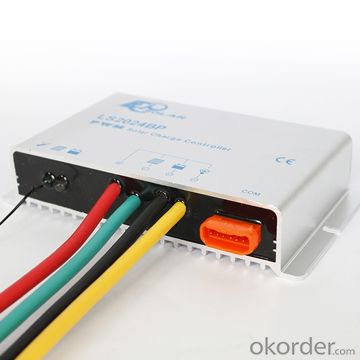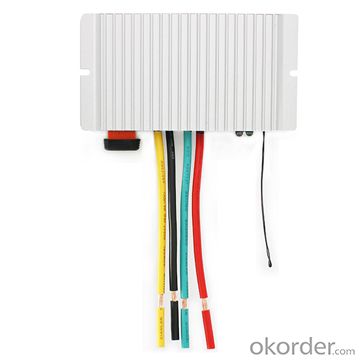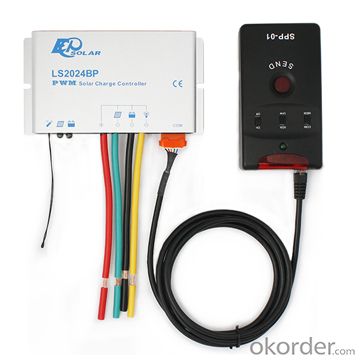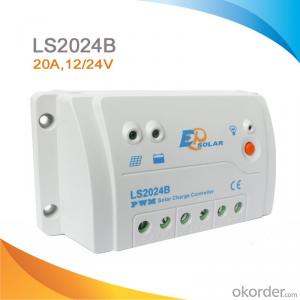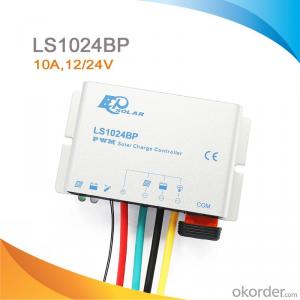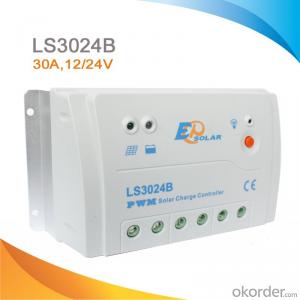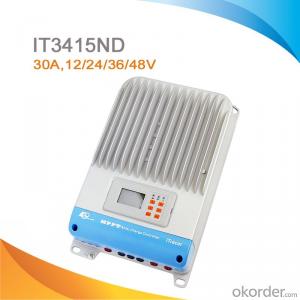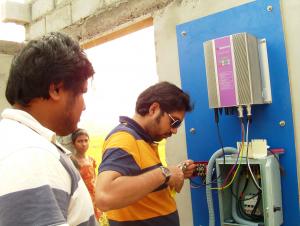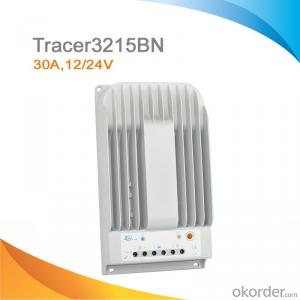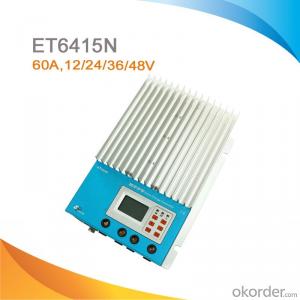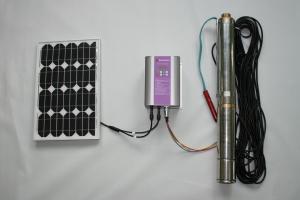Solar Controllers Rv Waterproof PWM Solar Charge Controller 20A, 12/24V, LS2024BP
- Loading Port:
- China main port
- Payment Terms:
- TT or LC
- Min Order Qty:
- -
- Supply Capability:
- -
OKorder Service Pledge
OKorder Financial Service
You Might Also Like
Features:
·12V/24V automatic identify or user-defined working voltage.
·High efficient Series PWM charging, increase the battery lifetime and improve the solar system performance.
·Use MOSFET as electronic switch, without any mechanical switch.
·Multiple load control modes, increase the flexibility of the load output
·Gel, Sealed, Flooded and user-defined battery type option.
·New SOC method of calculating accurately displays the available battery capacity.
·LandStar BP has no keys , The control function and the switch condition of the load can be modified by communication connection.
·Use of standard Modbus communication protocol for TTL-232 bus connections, communication protocol compatibility much better
·Support firmware upgrade
·Fully encapsulated PCB, IP67 protection
·Aluminumhousing
More powerful function via MT50 or PC
·Diversified load control modes : Manual, Light ON/OFF, Light ON+ Timer, Time Control
·Battery type selection: Gel, sealed, flooded and User type
·Real-time monitor
·Programmable parameters
·LVD or SOC load disconnect function
·Energy statistics function
Electronic Protections:
·PV array short circuit
·Over discharging
·Over charging
·Load overload
·Load short circuit
·PV reverse polarity
·Battery reverse polarity
·Overheating
Specification:
Electrical parameters | LS1024BP | LS2024BP |
Nominal System Voltage | 12 / 24V auto work | |
Rated Battery Current | 10A | 20A |
Maximum battery voltage | 34V | |
Grounding | Common positive | |
Self-consumption | 8.4mA(12V),7.8mA(24V) | |
Temp. compensation | -3mV/℃/2V(25℃ ref) | |
Equalize charging voltage | Sealed: 14.6V, Flooded: 14.8V, User-defined: 9~17V | |
Boost charging voltage | Gel: 14.2V, Sealed: 14.4V, Flooded: 14.6V, User-defined: 9~17V | |
Float charging voltage | Gel /Sealed /Flooded: 13.8V, User-defined: 9~17V | |
Low voltage reconnect voltage | Gel /Sealed /Flooded: 12.6V, User-defined: 9~17V | |
Low voltage disconnect voltage | Gel /Sealed /Flooded: 11.1V, User-defined: 9~17V | |
Working temp. | -35℃~+55℃ | |
Humidity | ≤95% (NC) | |
Enclosure | IP67 | |
Dimension | 108.5 x 64.5 x 25.6mm | 139 x 76.5 x 28mm |
Terminal | 4mm2 | 6mm2 |
Net weight | 0.4kg | 0.6kg |
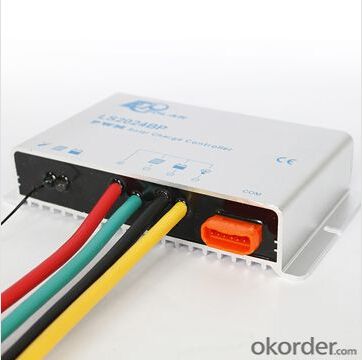
FAQ:
Q1. What is the voltage?
A1. Our 45/60A solar charge controller is 12/24/36/48V auto work.
Q2. What is the difference between MPPT&PWM?
A2. MPPT has higher efficiency, it can track the max power point and won't waste energy.
Q3. What is the efficiency of the MPPT controller?
A3. MPPT>99%, peak conversion efficiency>98%.
Q4. What is the waranty of product?
A4. 12 months.
Q5. What protection does your MPPT controller have?
A5. PV array short circuit, PV reverse polarity, Battery reverse polarity, Over charging, Output short circuit.
- Q: Can a solar controller be used with solar panels that are connected to a solar telecommunications system?
- Yes, a solar controller can be used with solar panels that are connected to a solar telecommunications system. A solar controller, also known as a charge controller, is an essential component in any solar power system. Its main function is to regulate the flow of electricity from the solar panels to the battery bank, ensuring that the batteries are charged efficiently and safely. In the case of a solar telecommunications system, where solar panels are used to power communication devices, a solar controller is even more important. It helps to protect the batteries from overcharging, which can damage the batteries and reduce their lifespan. Additionally, a solar controller can also prevent reverse current flow from the batteries to the solar panels during periods of low or no sunlight, which can also damage the panels. By using a solar controller, the solar panels in a telecommunications system can operate at their maximum efficiency, while the batteries are charged and maintained properly. This not only ensures reliable power supply for the telecommunication equipment but also extends the lifespan of the entire system. Therefore, it is highly recommended to use a solar controller in conjunction with solar panels that are connected to a solar telecommunications system to optimize the performance and longevity of the system.
- Q: How do I connect a solar controller to my solar panels?
- To connect a solar controller to your solar panels, follow these steps: 1. Identify the positive and negative terminals on both the solar panels and the solar controller. 2. Connect the positive terminal of the solar panel to the positive terminal of the solar controller using a suitable wire or cable. 3. Connect the negative terminal of the solar panel to the negative terminal of the solar controller using another appropriate wire or cable. 4. Ensure that the connections are secure and tight to avoid any loose connections or potential electrical hazards. 5. Once the connections are made, the solar controller should be able to regulate the flow of electricity from the solar panels to the battery or load, depending on your system setup. Remember to always refer to the manufacturer's instructions and guidelines specific to your solar controller and panels to ensure proper installation and connection.
- Q: How does a solar controller handle the monitoring of system performance?
- A solar controller handles the monitoring of system performance by continuously measuring the voltage and current output of the solar panels and comparing it with the expected values. It keeps track of the energy generated and consumed, battery status, and other relevant parameters. Additionally, it may have built-in sensors to detect temperature, irradiance, and other environmental factors that can affect system performance. Based on this information, the solar controller can optimize the charging and discharging of the batteries, ensure the system operates within safe limits, and provide real-time feedback on the overall performance of the solar system.
- Q: Can a solar controller be used with a solar-powered street light?
- Yes, a solar controller can be used with a solar-powered street light. A solar controller is an essential component of a solar-powered street light system as it regulates the power flow from the solar panel to the battery, preventing overcharging and extending the battery's lifespan. It also manages the lighting operation, controlling when the street light should turn on and off based on the battery's charge level. Overall, the solar controller plays a crucial role in optimizing the performance and efficiency of a solar-powered street light.
- Q: What is the maximum temperature range for a solar controller?
- The maximum temperature range for a solar controller typically varies depending on the specific model and manufacturer. However, in general, solar controllers can withstand temperature ranges from -40°C to +85°C (-40°F to +185°F).
- Q: Can a solar controller be used with solar-powered indoor commercial buildings?
- Solar-powered indoor commercial buildings can indeed utilize a solar controller. This device serves as a regulator between the solar panels, battery, or grid, controlling the flow of electrical energy. Its primary functions include managing the charging process, preventing battery overcharging or discharging, and maximizing solar panel energy output. The solar controller's role becomes particularly crucial in solar-powered indoor commercial buildings, as it guarantees the efficient utilization of generated solar energy for powering electrical systems and equipment. It effectively manages energy flow, stores excess energy in batteries for later use, and facilitates connection to the grid if necessary. Furthermore, a solar controller offers valuable data and monitoring capabilities, enabling building owners or operators to track and analyze energy production and consumption patterns. This information proves instrumental in optimizing energy usage, identifying areas for improvement, and potentially reducing energy costs. In conclusion, a solar controller is an indispensable component in the operation of solar-powered indoor commercial buildings. It ensures reliable and efficient functioning of electrical systems by regulating and optimizing energy flow.
- Q: How do you prevent voltage spikes with a solar controller?
- Voltage spikes can be prevented with a solar controller by implementing protective measures such as using surge protectors, transient voltage suppressors, or capacitors in the system. These components help to regulate and stabilize the voltage, preventing any sudden and potentially damaging increases in voltage.
- Q: Can a solar controller be used for battery charging in remote locations?
- Yes, a solar controller can be used for battery charging in remote locations. Solar controllers are designed to regulate the charging process of solar panels and efficiently charge the batteries. This makes them an ideal solution for remote locations where access to the main power grid may be limited or non-existent. By harnessing solar energy, the solar controller can charge batteries and provide a reliable power source in areas far away from civilization.
- Q: Can a solar controller be used with solar-powered irrigation systems?
- Yes, a solar controller can be used with solar-powered irrigation systems. A solar controller helps regulate and optimize the performance of solar panels, batteries, and pumps in an irrigation system. It ensures proper charging and discharging of batteries, controls water flow, and monitors system performance, making it a crucial component for efficient operation of solar-powered irrigation systems.
- Q: Are there any efficiency differences between PWM and MPPT solar controllers?
- PWM and MPPT solar controllers have efficiency differences. Compared to MPPT controllers, PWM controllers have a simpler design and are generally less expensive. However, they are less efficient at converting the solar panel's output to the battery's charging voltage. PWM controllers achieve voltage regulation by rapidly turning the solar panel's output on and off, resulting in a square wave output. This can lead to some energy loss because the solar panel's output voltage is not always perfectly matched to the battery's charging voltage. On the other hand, MPPT controllers utilize advanced algorithms to constantly adjust the solar panel's output voltage and current. This allows them to find the maximum power point, where the panel operates at its highest efficiency. By dynamically adjusting the charging voltage and current, MPPT controllers can extract more power from the solar panel and deliver it to the battery, resulting in overall higher system efficiency. MPPT controllers are especially advantageous when the solar panel's voltage is significantly higher than the battery's charging voltage. In such cases, using PWM controllers would result in substantial energy loss, while MPPT controllers can efficiently convert the higher voltage to the battery's required voltage. In summary, while PWM controllers are simpler and more affordable, MPPT controllers offer greater efficiency in converting solar energy to battery charging voltage. The choice between the two depends on factors such as cost, system design, and the specific requirements of the solar power system.
Send your message to us
Solar Controllers Rv Waterproof PWM Solar Charge Controller 20A, 12/24V, LS2024BP
- Loading Port:
- China main port
- Payment Terms:
- TT or LC
- Min Order Qty:
- -
- Supply Capability:
- -
OKorder Service Pledge
OKorder Financial Service
Similar products
Hot products
Hot Searches
Related keywords





